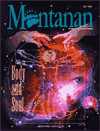
FALL 1999
CONTENTS
Keeping the Student Body Fit Harvest Moon
AROUND THE OVAL
SPORTS
CLASS NOTES
ALUMNI NOTES
Contact Us
About the Montanan
PAST ISSUES
 FALL 1999 CONTENTS Keeping the Student Body Fit Harvest Moon
AROUND THE OVAL Contact Us About the Montanan PAST ISSUES |
Divine Women
Medieval Women Mysticsby Kim Anderson
They described the soul as a deep abyss, a wilderness, a bottomless ocean, a desert. Unlike their male counterparts, they wrote in the vernacular rather than Latin. And they explored the connection between body and spirit more intensely than almost any of the world’s poets. These medieval women mystics emerged during the Middle Ages in Europe, says religious studies Professor Paul Dietrich, when the creation of religious orders provided the education, freedom from childbirth and material security that made it possible for a relatively large number of women to write. This has been a particularly rich field for feminist scholars, he says, and as a result, women such as Hildegard of Bingen, Christine de Pisan and Julian of Norwich have gained popularity. “Students really react to these writers, and part of it, I think, is the immediacy of the language,” says Dietrich. “These women weren’t, as a rule, taught Latin, so their writing had a close connection to the oral tradition. There’s an urgency and concreteness there that comes, in part, from writing in the primary language, but also from the absolute belief that God has commanded them to witness through their writing.” The connection between body and soul is particularly strong in many of these writers. As Dietrich points out, much of the writing deals with suffering. “Let’s face it,” he says, “before the twentieth century, illness and pain had to be endured rather than cured.”
But beyond the experience of physical pain lies the ecstasy of what scholars call love mysticism. “These women experienced a union with God lived out on earth,” Dietrich says. Take, for example, Hadewijch the Second’s expression of spirituality in “Poem Twenty-Six”: “Naked love who spares nothing/In her wild death./Stripped of all accident/Recovers her simple unity.” “They use all the conventions of the troubadours and love poets of the time,” Dietrich says. “They talk about the chase of love, the game of love, the coming of the bridegroom. And their descriptions of the union with the beloved acknowledge that the body plays a huge role in the mystical experience. Earlier scholars often understood these descriptions as a result of repressed sexuality, but when you read the work there’s nothing sublimated about it.” Dietrich, who received a doctorate in the history of Christianity from the University of Chicago, is working on a manuscript focusing on thirteenth- and fourteenth-century Dutch and German female mystics, including Mechthild of Magdeburg, Hadewijch of Brabant and Hadewijch the Second. “I became interested in these late medieval women writers in part because of the intensity of their work and their sense of life as a struggle,” Dietrich says. “There is a collection of writing that was long attributed to Hadewijch, but is now believed to have been written by someone else. The poems are very zen-like and spare. They deal with the soul’s stripping away of all that is nonessential. They are very concerned with detachment, and these are concepts that we now associate with certain aspects of zen.” In “Poem Twenty-Six,” for example, Hadewich writes: “It is in this wild and vast simplicity/That the poor in spirit live in unity:/There they find nothing but the freedom of detachment./Which always opens up to Eternity.” Dietrich says he has had an interest in religious thought since he was very young. “Wallace Stegner writes about how people who are raised in places without much of a so-called ‘civilized’ history--like the West--are drawn to the study of earlier times,” he says. “Maybe that’s where my interest in early religious thought began.”
AROUND THE OVAL• SPORTS • CLASS NOTES • ALUMNI NOTES FEEDBACK•STAFF • ABOUT THE MONTANAN •ARCHIVES HOME • CONTENTS
|